
13
Operation
PARTS MANUALS AVAILABLE ONLINE AT smithco.com
OPERATION
Run machine at half-throttle minimum, prior to operating traction pedal. This will ensure
proper brake release.
Before using the Spray Star, the operator and spray technician must familiarize themselves with all of the information on
chemical spraying contained in the Turf Spray Guide.
All testing and calibrating of sprayers is to be done with water, not chemicals. This insures the safety to all
involved in performing the calibration operation. Only after all calibration procedures are completed should
chemical be added to the sprayer.
HILLSIDE OPERATION
Do NOT stop or start suddenly on any slope. Be especially cautious when changing direction. Do NOT operate on
slopes greater than 10°.
BATTERY
Batteries normally produce explosive gases which can cause personal injury. Do not allow flames, sparks or any ig-
nited object to come near the battery. When charging or working near battery, always shield your eyes and always pro-
vide proper ventilation.
Battery cable should be disconnected before using “Fast Charge”.
Charge battery at 15 amps for 10 minutes or 7 amps for 30 minutes. Do not exceed the recommended charging rate. If
electrolyte starts boiling over, decrease charging.
Always remove grounded (-) battery clamp first and replace it last. Avoid hazards by:
1.
Filling batteries in well-ventilated areas.
2.
Wear eye protection and rubber gloves.
3.
Avoid breathing fumes when electrolyte is added.
4.
Avoid spilling or dripping electrolyte.
Battery Electrolyte is an acidic solution and should be handled with care. If electrolyte is splashed on
any part of your body, flush all contact areas immediately with liberal amounts of water. Get medical
attention immediately.
JUMP STARTING
Use of booster battery and jumper cables. Particular
care should be used when connecting a booster
battery. Use proper polarity in order to prevent sparks.
To jump start (negative grounded battery):
1.
Shield eyes.
2.
Connect ends of one cable to positive (+) terminals of each
battery, first (A) then (B).
3.
Connect one end of other cable to negative (-) terminal of "good" battery (C).
4.
Connect other end of cable (D) to engine block on unit being started (NOT to negative (-) terminal of battery)
To prevent damage to other electrical components on unit being started, make certain that engine is at idle speed
before disconnecting jumper cables.
















































